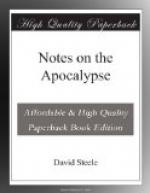17. And thus I saw the horses in the vision, and them that sat on them, having breastplates of fire, and of jacinth, and brimstone: and the heads of the horses were as the heads of lions; and out of their mouths issued fire, and smoke, and brimstone.
18. By these three was the third part of men killed, by the fire, and by the smoke, and by the brimstone, which issued out of their mouths.
19. For their power is in their mouth, and in their tails: for their tails were like unto serpents, and had heads, and with them they do hurt.
Vs. 13-19.—At the sounding of the sixth trumpet, a “voice comes from the four horns of the golden altar,” the immediate presence of the Almighty. This indicates punishment to be inflicted upon men for corrupting the gospel, similar to the judgment of fire from the “golden censer,” (ch. viii. 5.) The effects of the first woe may be supposed to reach from the early part of the seventh century to the latter part of the thirteenth,—the period of Arabian locusts. During the latter part of this time, the Turks were held in check by the Crusaders, who strove to wrest the Holy Land from the infidels. The “four angels” are the four Turkish Sultanies. The river Euphrates is to be taken in this place literally, as designating the geographical locality of these combined powers, which were the instruments employed by the enthroned Mediator, to demolish the remaining part of the Roman empire,—“the third part of men.” The time occupied in this barbarous work of slaughter is “an hour, a day, a month and a year,” about equal to 391 years; or from the year 1281 to 1672. The Western empire had been overthrown by the first four trumpets, the Eastern nearly ruined under the fifth; and under the sixth it was finally subverted. The numbers which the Turks brought into the field are here said to be “two hundred thousand thousand,”—a definite for an indefinite number as usual, a vast army. And historians tell us that they were, in fact, from four to seven hundred thousand, and a large proportion of them cavalry.
From the year 1672, one of their own historians dates the “Decay of the Othman empire!” Since that date, the Turkish power is well known to have been straitened by the Russian empire.
These eastern warriors and their horses are described by their military costume and their arms. Fire is red, jacinth blue, and brimstone yellow,—the chosen colors of the Ottoman warriors, their military uniform. The heads of their horses “as the heads of lions,” denote strength, fierceness and cruelty. “Fire, smoke and brimstone issuing out of their mouths,” may be supposed to indicate the employment of gunpowder, first invented about that time, as an element of destruction. The commander at the siege of Constantinople is said to have employed cannon, some of which were of such caliber as to send stones of three hundred pounds weight! Thus their power was in their “mouth:”




